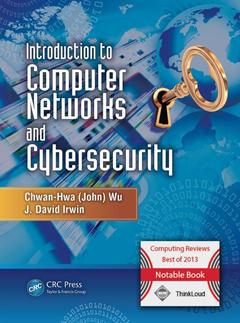Introduction to Computer Networks and Cybersecurity
Auteurs : Wu Chwan-Hwa (John), Irwin J. David

If a network is not secure, how valuable is it? Introduction to Computer Networks and Cybersecurity takes an integrated approach to networking and cybersecurity, highlighting the interconnections so that you quickly understand the complex design issues in modern networks. This full-color book uses a wealth of examples and illustrations to effectively connect the principles of networks and networking protocols with the relevant cybersecurity issues.
Get the Fundamentals of Internet Architecture and the Protocol Layers
Organized into six parts, the book walks you through the fundamentals, starting with the way most people first encounter computer networks?through the Internet architecture. Part 1 covers the most important Internet applications and the methods used to develop them. Part 2 discusses the network edge, consisting of hosts, access networks, LANs, and the physical media used with the physical and link layers. Part 3 explores the network core, including packet/circuit switches, routers, and the Internet backbone, and Part 4 examines reliable transport and the management of network congestion.
Learn about Malware and Security Systems
Building on the concepts and principles, the book then delves into state-of-the-art cybersecurity mechanisms in Part 5. It reviews the types of malware and the various security systems, made up of firewalls, intrusion detection systems, and other components. Crucially, it provides a seamless view of an information infrastructure in which security capabilities are built in rather than treated as an add-on feature. The book closes with a look at emerging technologies, including virtualization and data center and cloud computing unified communication.
Understand Cyber Attacks?and What You Can Do to Defend against Them
This comprehensive text supplies a carefully designed introduction to both the fundamentals of networks and the latest advances in Internet security. Addressing cybersecurity from an Internet perspective, it prepares you to better understand the motivation and methods of cyber attacks and what you can do to protect the networks and the applications that run on them.
Pedagogical Features
The book?s modular design offers exceptional flexibility, whether you want to use it for quick reference, self-study, or a wide variety of one- or two-semester courses in computer networks, cybersecurity, or a hybrid of both. Learning goals in each chapter show you what you can expect to learn, and end-of-chapter problems and questions test your understanding. Throughout, the book uses real-world examples and extensive illustrations and screen captures to explain complicated concepts simply and clearly. Ancillary materials, including PowerPoint® animations, are available to instructors with qualifying course adoption.
An Introduction to Information Networks. Applications: The Application Layer. DNS and Active Directory. XML-Based Web Services. Socket Programming. Peer-to-Peer (P2P) Networks and Applications. Link and Physical Layers: The Data Link Layer and Physical Layer. The Ethernet and Switches. Virtual LAN, Class of Service, and Multilayer Networks. Wireless and Mobile Networks. Network Layer: The Network Layer. IPv6. Routing and Interior Gateways. Border Gateway Routing. Transport Layer: The Transport Layer. Packet Loss Recovery. TCP Congestion Control. Cyber Security: Cyber Security Overview. Firewalls. Intrusion Detection/Prevention System. Hash and Authentication. Symmetric Key Ciphers and Wireless LAN Security. Public Key Cryptography, Infrastructure and Certificates. Secure Socket Layer/Transport Layer Security (SSL/TLS) Protocols for Transport Layer Security. Virtual Private Networks for Network Layer Security. Network Access Control and Wireless Network Security. Cyber Threats and Their Defense. Emerging Technologies: Network and Information Infrastructure Virtualization. Unified Communications and Multimedia Protocols. Glossary of Acronyms. Index.
Chwan-Hwa "John" Wu joined the faculty of Auburn University, Alabama, in 1987, and is currently a professor of electrical and computer engineering. He has been the principal investigator on research projects funded by NSF, the U.S. Army, NASA, USDA, and many companies, including Northrop Grumman and Lockheed Martin. His current research interests include cybersecurity. He is an author and co-author of two books, 58 journal papers, and more than 130 conference publications. He also holds five U.S. patents. Dr. Wu is a Fellow of the IEEE.
J. David Irwin joined Auburn University, Alabama, in 1969, and is currently the Earle C. Williams Eminent Scholar in the Electrical and Computer Engineering Department. He is the author or co-author of numerous publications, including 17 textbooks. He has held numerous positions within the IEEE, including president of both the Industrial Electronics and Education Societies, as well as editor-in-chief of the IEEE Transactions on Industrial Electronics. He is a Life Fellow of the IEEE and a Fellow of both the ASEE and the AAAS. He is the recipient of numerous education and technical awards.
Date de parution : 02-2013
Ouvrage de 1336 p.
21x28 cm
Disponible chez l'éditeur (délai d'approvisionnement : 15 jours).
Prix indicatif 220,72 €
Ajouter au panierThèmes d’Introduction to Computer Networks and Cybersecurity :
Mots-clés :
UDP Packet; TCP Connection; Computer Networks; IPv6 Address; Computer Security; Mac Address; Computer Networking; Forwarding Table; Cybersecurity; Destination Mac Address; Information Security; IPv4 Address; HTTP Request; IP Address; Elliptic Curve; Sliding Window; Nat Device; VPN Client; Subnet Mask; Private Key; Routing Table; Access Network; Address Space; Duplicate Ack; Information Infrastructure; Sip Server; Public Key; IP Datagram; Post Method; Fast Retransmit



